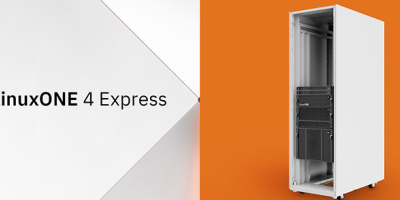- Delivers 127 qubits on a single IBM quantum processor for the first time with breakthrough packaging technology
- New processor furthers IBM's industry-leading roadmaps for advancing the performance of its quantum systems
- Previews design for IBM Quantum System Two, a next generation quantum system to house future quantum processors
IBM today announced its new 127-quantum bit (qubit) 'Eagle' processor at the IBM Quantum Summit 2021, its annual event to showcase milestones in quantum hardware, software, and the growth of the quantum ecosystem. The 'Eagle' processor is a breakthrough in tapping into the massive computing potential of devices based on quantum physics. It heralds the point in hardware development where quantum circuits cannot be reliably simulated exactly on a classical computer. IBM also previewed plans for IBM Quantum System Two, the next generation of quantum systems.
Quantum computing taps into the fundamental quantum nature of matter at subatomic levels to offer the possibility of vastly increased computing power. The fundamental computational unit of quantum computing is the quantum circuit, an arrangement of qubits into quantum gates and measurements. The more qubits a quantum processor possesses, the more complex and valuable the quantum circuits that it can run.
IBM recently debuted detailed roadmaps for quantum computing, including a path for scaling quantum hardware to enable complex quantum circuits to reach Quantum Advantage, the point at which quantum systems can meaningfully outperform their classical counterpoints. Eagle is the latest step along this scaling path.
IBM measures progress in quantum computing hardware through three performance attributes: Scale, Quality and Speed. Scale is measured in the number of qubits on a quantum processor and determines how large of a quantum circuit can be run. Quality is measured by Quantum Volume and describes how accurately quantum circuits run on a real quantum device. Speed is measured by CLOPS (Circuit Layer Operations Per Second), a metric IBM introduced in November 2021, and captures the feasibility of running real calculations composed of a large number of quantum circuits.
127-qubit Eagle processor
'Eagle' is IBM's first quantum processor developed and deployed to contain more than 100 operational and connected qubits. It follows IBM's 65-qubit 'Hummingbird' processor unveiled in 2020 and the 27-qubit 'Falcon' processor unveiled in 2019. To achieve this breakthrough, IBM researchers built on innovations pioneered within its existing quantum processors, such as a qubit arrangement design to reduce errors and an architecture to reduce the number of necessary components. The new techniques leveraged within Eagle place control wiring on multiple physical levels within the processor while keeping the qubits on a single layer, which enables a significant increase in qubits.
The increased qubit count will allow users to explore problems at a new level of complexity when undertaking experiments and running applications, such as optimizing machine learning or modeling new molecules and materials for use in areas spanning from the energy industry to the drug discovery process. 'Eagle' is the first IBM quantum processor whose scale makes it impossible for a classical computer to reliably simulate. In fact, the number of classical bits necessary to represent a state on the 127-qubit processor exceeds the total number of atoms in the more than 7.5 billion people alive today.
"The arrival of the 'Eagle' processor is a major step towards the day when quantum computers can outperform classical computers for useful applications," said Dr. Darío Gil, Senior Vice President, IBM and Director of Research. "Quantum computing has the power to transform nearly every sector and help us tackle the biggest problems of our time. This is why IBM continues to rapidly innovate quantum hardware and software design, building ways for quantum and classical workloads to empower each other, and create a global ecosystem that is imperative to the growth of a quantum industry."
The first 'Eagle' processor is available as an exploratory device on the IBM Cloud to select members of the IBM Quantum Network.
For a more technical description of the 'Eagle' processor, read this blog.
IBM Quantum System Two
In 2019, IBM unveiled IBM Quantum System One, the world's first integrated quantum computing system. Since then, IBM has deployed these systems as the foundation of its cloud-based IBM Quantum services in the United States, as well as in Germany for Fraunhofer-Gesellschaft, Germany's leading scientific research institution, in Japan for the University of Tokyo, and a forthcoming system in the U.S. at Cleveland Clinic. In addition, we announced today a new partnership with Yonsei University in Seoul, South Korea, to deploy the first IBM quantum system in the country. For more details, click here.
As IBM continues scaling its processors, they are expected to mature beyond the infrastructure of IBM Quantum System One. Therefore, we're excited to unveil a concept for the future of quantum computing systems: IBM Quantum System Two. IBM Quantum System Two is designed to work with IBM's future 433-qubit and 1,121 qubit processors.
"IBM Quantum System Two offers a glimpse into the future quantum computing datacenter, where modularity and flexibility of system infrastructure will be key towards continued scaling," said Dr. Jay Gambetta, IBM Fellow and VP of Quantum Computing. "System Two draws on IBM's long heritage in both quantum and classical computing, bringing in new innovations at every level of the technology stack."
Central to IBM Quantum System Two is the concept of modularity. As IBM progresses along its hardware roadmap and builds processors with larger qubit counts, it is vital that the control hardware has the flexibility and resources necessary to scale. These resources include control electronics, which allow users to manipulate the qubits, and cryogenic cooling, which keeps the qubits at a temperature low enough for their quantum properties to manifest.
IBM Quantum System Two's design will incorporate a new generation of scalable qubit control electronics together with higher-density cryogenic components and cabling. Furthermore, IBM Quantum System Two introduces a new cryogenic platform, designed in conjunction with Bluefors, featuring a novel, innovative structural design to maximize space for the support hardware required by larger processors while ensuring that engineers can easily access and service the hardware.
In addition, the new design brings the possibility to provide a larger shared cryogenic work-space – ultimately leading to the potential linking of multiple quantum processors. The prototype IBM Quantum System Two is expected to be up and running in 2023.
Statements regarding IBM's future direction and intent are subject to change or withdrawal without notice and represent goals and objectives only.
About IBM
For more information, visit: https://research.ibm.com/quantum-computing.






















 More than ever, there is a demand for IT to deliver innovation. Your IBM i has been an essential part of your business operations for years. However, your organization may struggle to maintain the current system and implement new projects. The thousands of customers we've worked with and surveyed state that expectations regarding the digital footprint and vision of the company are not aligned with the current IT environment.
More than ever, there is a demand for IT to deliver innovation. Your IBM i has been an essential part of your business operations for years. However, your organization may struggle to maintain the current system and implement new projects. The thousands of customers we've worked with and surveyed state that expectations regarding the digital footprint and vision of the company are not aligned with the current IT environment. TRY the one package that solves all your document design and printing challenges on all your platforms. Produce bar code labels, electronic forms, ad hoc reports, and RFID tags – without programming! MarkMagic is the only document design and print solution that combines report writing, WYSIWYG label and forms design, and conditional printing in one integrated product. Make sure your data survives when catastrophe hits. Request your trial now! Request Now.
TRY the one package that solves all your document design and printing challenges on all your platforms. Produce bar code labels, electronic forms, ad hoc reports, and RFID tags – without programming! MarkMagic is the only document design and print solution that combines report writing, WYSIWYG label and forms design, and conditional printing in one integrated product. Make sure your data survives when catastrophe hits. Request your trial now! Request Now. Forms of ransomware has been around for over 30 years, and with more and more organizations suffering attacks each year, it continues to endure. What has made ransomware such a durable threat and what is the best way to combat it? In order to prevent ransomware, organizations must first understand how it works.
Forms of ransomware has been around for over 30 years, and with more and more organizations suffering attacks each year, it continues to endure. What has made ransomware such a durable threat and what is the best way to combat it? In order to prevent ransomware, organizations must first understand how it works. Disaster protection is vital to every business. Yet, it often consists of patched together procedures that are prone to error. From automatic backups to data encryption to media management, Robot automates the routine (yet often complex) tasks of iSeries backup and recovery, saving you time and money and making the process safer and more reliable. Automate your backups with the Robot Backup and Recovery Solution. Key features include:
Disaster protection is vital to every business. Yet, it often consists of patched together procedures that are prone to error. From automatic backups to data encryption to media management, Robot automates the routine (yet often complex) tasks of iSeries backup and recovery, saving you time and money and making the process safer and more reliable. Automate your backups with the Robot Backup and Recovery Solution. Key features include: Business users want new applications now. Market and regulatory pressures require faster application updates and delivery into production. Your IBM i developers may be approaching retirement, and you see no sure way to fill their positions with experienced developers. In addition, you may be caught between maintaining your existing applications and the uncertainty of moving to something new.
Business users want new applications now. Market and regulatory pressures require faster application updates and delivery into production. Your IBM i developers may be approaching retirement, and you see no sure way to fill their positions with experienced developers. In addition, you may be caught between maintaining your existing applications and the uncertainty of moving to something new. IT managers hoping to find new IBM i talent are discovering that the pool of experienced RPG programmers and operators or administrators with intimate knowledge of the operating system and the applications that run on it is small. This begs the question: How will you manage the platform that supports such a big part of your business? This guide offers strategies and software suggestions to help you plan IT staffing and resources and smooth the transition after your AS/400 talent retires. Read on to learn:
IT managers hoping to find new IBM i talent are discovering that the pool of experienced RPG programmers and operators or administrators with intimate knowledge of the operating system and the applications that run on it is small. This begs the question: How will you manage the platform that supports such a big part of your business? This guide offers strategies and software suggestions to help you plan IT staffing and resources and smooth the transition after your AS/400 talent retires. Read on to learn:
LATEST COMMENTS
MC Press Online